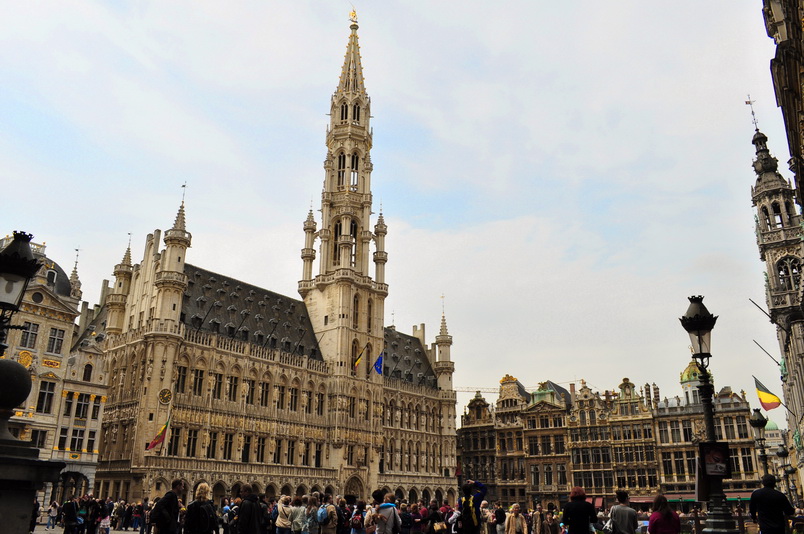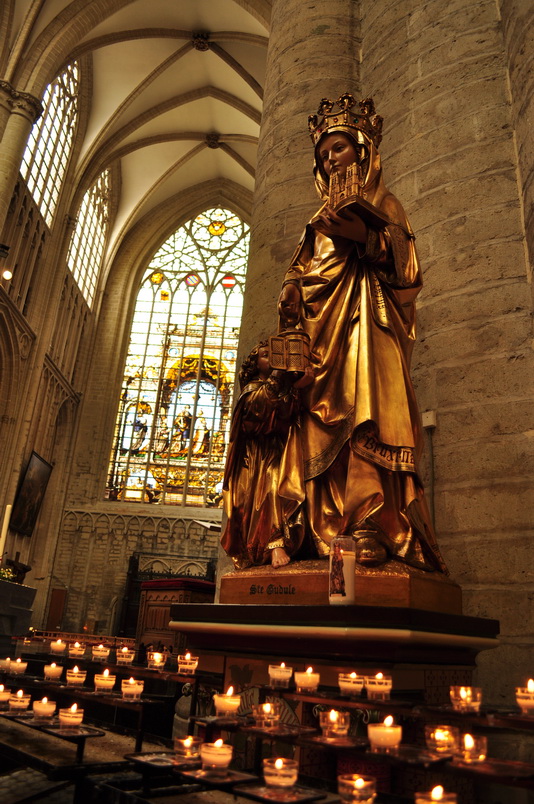Belgium. Brussels
Brussels is the capital of Belgium and the Brussels-Capital Region. The city's name originates from the Old Dutch "bruocsela," meaning "settlement in the marsh." Today, Brussels is also the capital of the European Union (EU), hosting the headquarters of NATO and the Benelux secretariat. Belgium, and Brussels in particular, are famous for producing a wide variety of beers, chocolates, and waffles with different shades and flavors...
The Atomium is one of the main attractions and symbols of Brussels. It was designed for the 1958 World Expo as a symbol of the atomic age and the peaceful use of atomic energy...
In honor of the 50th anniversary of Belgian independence, the Brussels Triumphal Arch was built, which is also a popular site in the city...
Heading closer to the center of the capital, we encountered the Royal Palace, which remains the official residence of the Belgian monarch...
Unlike the iconic Notre-Dame Cathedral in Paris, the Cathedral of St. Michael and St. Gudula in Brussels is relatively unknown to the general public, although it is an equally beautiful Gothic structure...
The cathedral is named after Saint Michael, the patron saint of Brussels, and Gudula, the daughter of a 7th-century Carolingian aristocrat, whose relics have been kept here for over 1,000 years. According to legend, this young and devout Brussels resident was constantly disturbed by a pesky demon who would blow out her candle as she read religious books at night. Each time, she would relight the candle, and for this perseverance, she was canonized. The main facade of the cathedral features four doors with three pointed portals and sculptures of saints above them...
The Romanesque columns supporting the vault are adorned with statues of the twelve apostles, while the choir, executed in primary Gothic style, is illuminated by tall windows adorned with 16th-century stained glass...
Next, our route led us to the city's central square, passing through the so-called "Mountain of Arts"...
From here, there was a beautiful view of the Lower Town, which includes the historic center of Brussels with the town hall, residential houses, and craftsmen's homes...
The heart of the city is Grand Place, a square measuring 110 meters long and 68 meters wide. It is surrounded by houses built in the 17th century, each with its name and originally belonging to specific guilds...
Several of the most famous guild houses depicted in the following photograph (from left to right): the "Fox" house was the former home of the haberdashery guild (selling items like ties, gloves, scarves, bags, etc.); the "She-Wolf" house belonged to the archers' guild and is decorated with statues and sculptures. Statues on the third floor represent Truth, Lie, Discord, and Peace. A gilded phoenix rises on the roof; the "Bag" house was built in 1644 for woodworkers and coopers; the "Cart" house, constructed in 1697 by the guild of fat and oil producers, has a niche with a statue of Saint Giles, the patron saint of this guild; the "House of Bakers" or "The King of Spain" was built by the bakers' guild. This guild was one of the largest and wealthiest in the city. Above the door is a bronze bust of Saint Aubert, the patron saint of bakers. In the middle of the fourth floor, in a decorative element, is a bust of King Charles II of Spain. The top of the house is crowned with an octagonal dome, above which stands Glory, holding a flag...
The square also features the Town Hall, a masterpiece of Gothic architecture. The construction of the Brussels Town Hall took place in three stages. The left wing, the longer one, was built in 1402 by Jacob van Thienen. The right wing was completed in 1445 by an unknown architect. In 1450, the building was crowned with a 90-meter tower with a statue of the Archangel Michael, the patron saint of Brussels...
The "King's House" dates back to the 13th century and originally served as a storage space for bakers. Over the centuries, it has been repeatedly remodeled and rebuilt. It was even temporarily used as a prison. Since foreign governors performed some royal functions here, it became known as the "King's House," although no king ever lived there...
The primary symbol of Belgium's capital for many is Manneken Pis. This statue, which has been stolen and restored several times, originated in the 17th century and is believed to embody the rebellious spirit of the Brussels burghers...
One notable fact about Belgian life is the annual production of chocolate. Belgium produces about 220,000 tons of chocolate each year. Brussels' national airport is considered the largest point of chocolate sales in the world. However, as we are traveling by bus through Belgium, we must make do with the numerous chocolate shops that create an extraordinarily delicious atmosphere, luring us in with their appetizing displays...
Brussels waffles are another highlight not to be missed, a delicious dessert that must be tried...
The streets of the old part of the city delight with their charm...
A significant role in Belgium is played by the production of beer, with a variety of about 900 different brands, some of which are 400-500 years old. In the past, the number of breweries in Belgium was comparable to the number of churches. Each brewery had its beer, its water source, and its brewer. One Belgian politician aptly described the social role of beer: "A wine lover talks to his glass, but a beer lover talks to his neighbor" ...
Such is the interesting and unique capital of the Eurozone and Belgium. The delightful aromas of the "chocolate streets" left a lasting impression, leading us to associate Brussels with a sweet and delicious city...























































Comments
Post a Comment